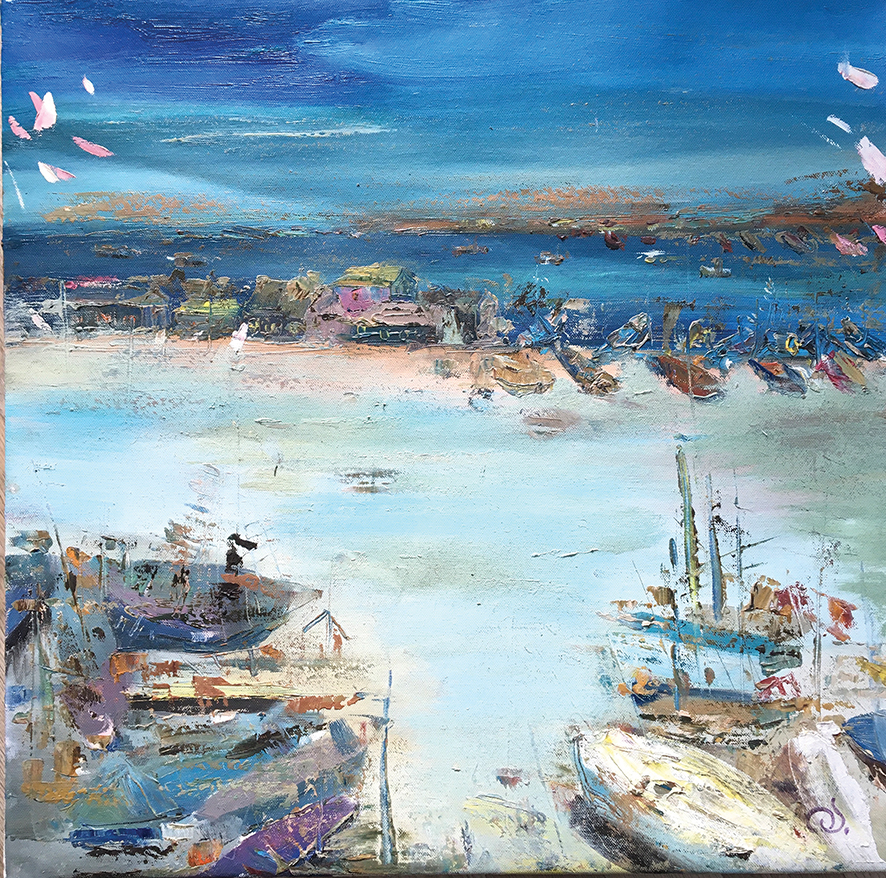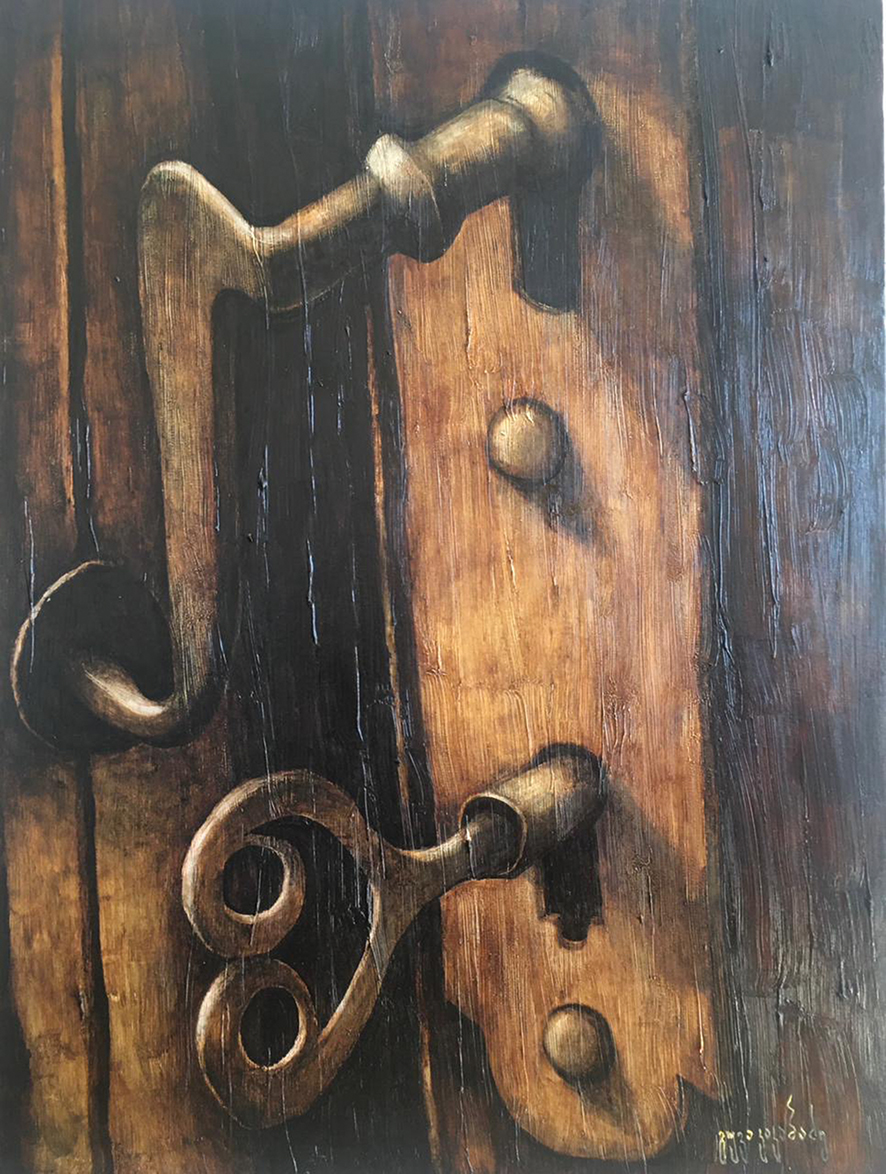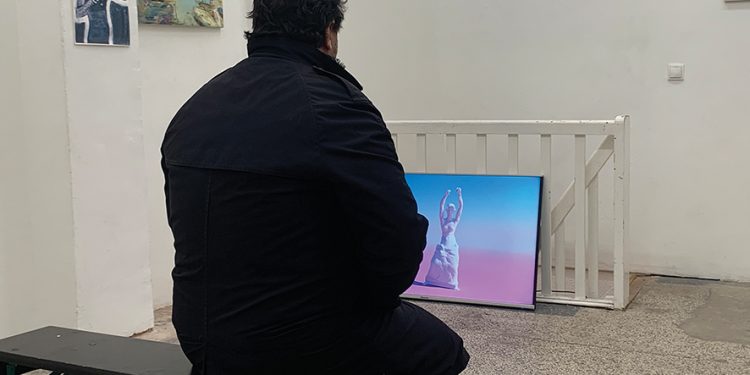In his evocative cycle of paintings, Georgian artist Guga Kakabadze represents the recurrent motive of old-fashioned gates and doors crafted from heavy wood and intricate paneling. These take center stage in his newest paintings, their polished surfaces bearing the marks of time and history. Each door is adorned with heavy metal locks, their gleaming forms matching with aged wood. Nearby, chests of drawers with locks stand sentinel, their imposing presence hinting at secrets and imaginary treasures hidden within. Through the artist’s skillful rendering, these common parts of interiors become more than mere architectural features—they are symbols of mystery, nostalgia, and the passage of time.
Guga Kakabadze’s paintings are masterfully crafted, the artist’s skill in realistically capturing the intricate wood structure and shadows of the locks imbues each scene with a palpable sense of realism. Every knot, grain, and pattern of wood paneling is meticulously rendered, giving a tactile sensation that transports viewers into the heart of the scene. The shadows cast by the heavy metal locks play across the wood’s surface with precision and nuance, creating an illusion of depth that makes it appear as if one could reach out and touch the rugged texture. In some works, faint sunlight creeps into the scenery, adding to the mysterious aura. Through the artist’s craftsmanship, his use of trompe l’oueil technique and reduced color palette of light and darker hues of brown invite us to linger, wondering if it is any good at all to keep knocking at closed doors. The locked gates leave the mysteries behind them veiled.

Kakabadze’s windmill and edifice paintings series investigates abandoned landscapes, with towering buildings and windmills placed in the center of the composition. Painted in hues of white, against ominous orange backgrounds their weathered wings look as if spinning lazily in the breeze. Architecture acquires here symbolic meaning: e.g. windmills recall Don Quixote’s vain and senseless fights with windmills, whereas anthropomorphic buildings get a surreal touch reminding us of sad faces and crouched human figures. Delapidated edifices loom like ancient guardians, their crumbling facades lending an air of mystery and intrigue to the scene. Rendered with a dreamlike quality, the landscape takes on an otherworldly aura, as if plucked from the realms of fantasy and surrealism. Amidst these haunting tableaus, a tiny man figure emerges as a signature recurring motif, a solitary wanderer navigating the vast expanse of the abandoned terrain. Through the artist’s skillful rendering, these scenes open up a realm where reality blurs with imagination, revealing the hidden depths of the subconscious.
The works are on view at the local community center Nachbarschaftszentrum Brunnentreff of the Volkssolidarität Berlin, as part of the Art in Public Spaces Project, an intervention inviting international artists to show their works in the city center. It takes place not far from the famous Berlin Wall Memorial, in the newly upgraded hipster part of the Brunnenstrasse, where many of the former dwellers of the GDR had to leave due to sky-rocketing apartment rent and gentrification.
Another exhibition worth mentioning in this context, currently on in Hamburg, is dedicated to the ancient myth of antiquity – Medea, and takes place in the hinterconti artist-run space. Entitled “Medea’s Daughters. Eternity Is a Lie,” it focuses on the feminist artistic positions and offers an unconventional interpretation of this centuries-old legend. The aim of the project is to subvert and critically inquire of patriarchal narratives and representations of women in art historical canon, visually analyzing the protagonists of the ancient myth from the perspective of the female gaze. Questioned is also the notion of eternity, as something imposed on one as a burden, a method of oppression and an unrealistic utopia.
Realised in cooperation with hinterconti Hamburg, this exhibition is one of the unique shows that, among others, brings up the discourse about the two versions of the Medea myth – one commonly known in Georgia through folklore and oral literary tradition, and the other widely accepted in the West based on the classical Greek tragedy of Medea by Euripides. Eleven Georgian women artists and one artist from Frankfurt each render their view and understanding of Medea and her evolvement through time. In what way is Medea relevant to us today?

Interestingly enough, according to Georgian folklore, Medea was the daughter of Aieti, King of Colchis – an antique kingdom that included the territories of the current Western Georgia, Abkhazia and parts of the Black Sea coast of the current Turkey. Colchis was famous for its mythic affluence, especially its main treasure – the Golden Fleece – that coveted object of desire that made Jason and the Arganauts sail off from the Greek coasts to steal it. Medea, who fell madly in love with Jason, helped him in the theft, thus betraying her homeland. She had to flee together with Jason and her children to Greece, where she was in her turn betrayed by Jason, who left her for the princess of Corinth.
According to Levan Berdzenishvili, a researcher and expert on ancient history and literature, Medea didn’t in fact kill her children out of jealousy. It was Euripides, who, inspired by the legend, made it into a tragedy. Medea went into history as the femme-fatale, an ominous murderer, leaving destruction and animosities behind her, whereas Jason remains the celebrated hero of impeccable reputation. Medea was never accepted by the Greeks as an equal, since she was considered a barbarian coming from the land outside Corinth – most doors were closed to her as a foreigner. Prejudices, bias and envy keep many doors still closed to women, refugees, minorities or populations of geo-politically less relevant countries, like those of the former Soviet block, newly independent states whose full integration into cultural European community is a stagnating process – all of which brings us back to Guga Kakabadze’s locked gates and windmills. Yet not all doors are as closed as they seem; there is hope. Struggling for justice, equity, more rights and freedoms makes far more sense than hopeless fighting with windmills.
About hinterconti
Hinterconti is an association of artists and cultural workers. As a non-profit association, its members have been regularly organizing exhibitions by national and international artists since 1999.
The focus of the exhibitions and projects is to offer artists a forum for their artistic practices. Hinterconti gives artists the space to develop their ideas, to outline questions, or to publicly show works in progress that will not necessarily be seen in the usual art market and exhibition context. The association operates with the kind support of the Authority for Culture and Media, Hamburg.
Both exhibitions in Berlin and in Hamburg are curated by myself, Lily Fürstenow. A curator’s guide to “Medea’s Daughters. Eternity Is a Lie” at hinterconti Hamburg is scheduled on the 16th and 17th of March, 3pm to 8pm. More details online: https://www.hinterconti.de/2024/02/medeas-daughters-eternity-is-a-lie-curated-by-lily-fuerstenow-8-3-16-3/
Review by Lily Fürstenow














